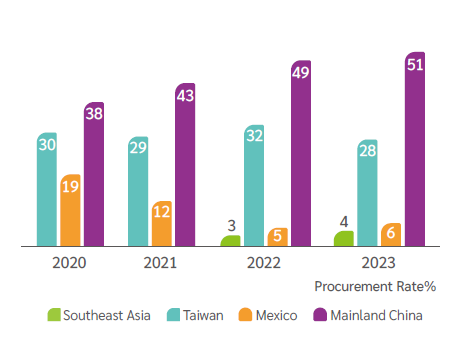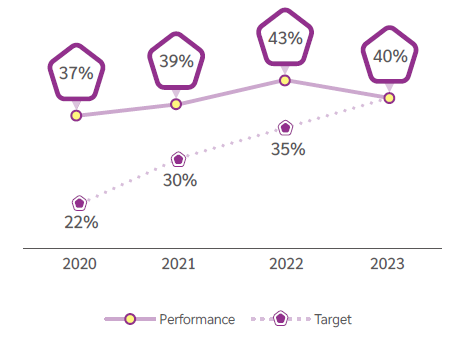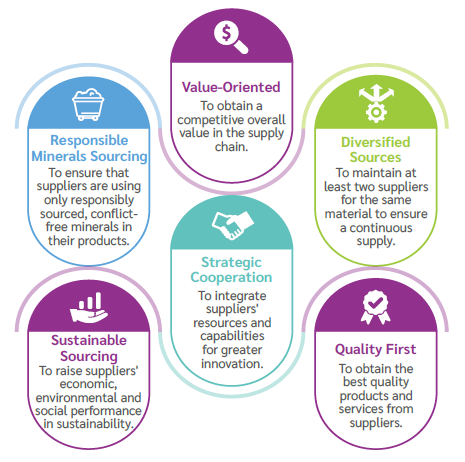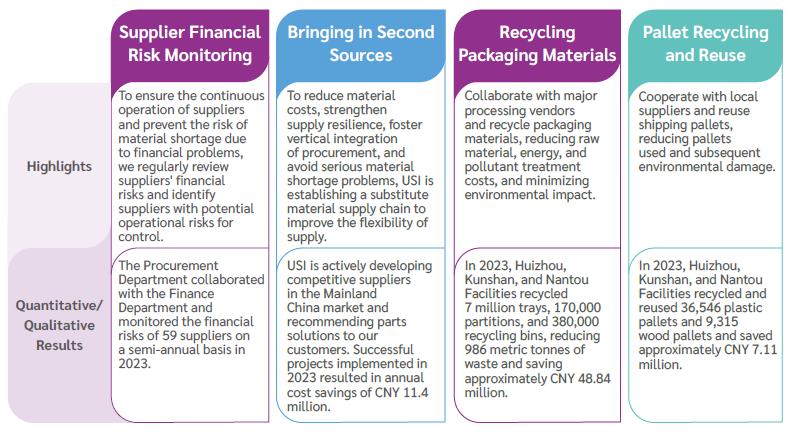
Value Chain Management
Supply Chain Management
To build a sustainable supply chain, we are adjusting our procurement strategy according to global industry trends and adopting various procurement strategies according to the major categories of raw materials to diversify our sources of supply to reduce risks and ensure competitive pricing, reasonable cost, accurate delivery, and sound quality.
USI supports local suppliers. This strategy not only facilitates the growth of the local economy and local employment rates, but also effectively saves energy and time consumed in transportation, helping us to minimize the impact on our environment. Therefore, our raw materials are primarily purchased from local or nearby suppliers. The procurement situation of local raw material suppliers in 2023 is shown in the figure below, the proportion of each region is 51% in Mainland China, 6% in Mexico, and 28% in Taiwan, and 4% in Southeast Asia, and the average proportion of local procurement of integrated manufacturing plants in the global local procurement is 40%. Our strategic procurement department will continue to strengthen the management of target suppliers and select local vendors with competitive advantages to enhance the competitive advantage of the local industry and strengthen the partnership with suppliers.
Percentage of Procurement from Local Suppliers at All Facilities:

Global Local Procurement Rate:

As the supply chain is the essential link of our value chain and an extension of USI's values, USI has established the Supplier Code of Conduct. The Company also responds to the international biodiversity trend and ecological system balanced co-existence and forest conservation, included biodiversity, zero deforestation and land conservation in the code of conduct, such that the supply chain would be able to jointly reduce the impact of business operations on the ecological environment and maintain the stability and balance of the global ecosystem. In the Code, suppliers are required to comply with the laws and regulations of the countries in which they operate, as well as the requirements for business conduct in the areas of labor, health and safety, the environment, ethics, and management systems and monitor their suppliers' compliance with the Code. In 2023, 100% of the suppliers were educated on the Code of Conduct, and we did not receive any reports or complaints of violations from suppliers.
The Code is made up of five sections. Sections A, B, and C outline Labor, Health & Safety, and Environment standards. Section D is standards related to Business Ethics. Section E outlines the elements of an acceptable system to manage compliance with this Code.
USI fully understands that the overall power of procurement is a unique resource. In order to pursue sustainable growth, we have developed six major supply chain strategies and evaluated the sustainability value of different projects such as supply chain diversity and sustainable procurement. With the development and progress of these projects, the Company shall continue to improve overall supply chain resilience, we hope to create a mutually beneficial future for our customers, our company, and our suppliers by developing stable partnerships with them.
Supply Chain Management Strategy:

Sustainable Supply Chain Projects:

USI has a standardized supplier evaluation system to protect human rights and the environment, provide high-quality products, and meet future trends. We base our supplier selection on this system and our procurement strategy and hope to jointly establish a sustainable supply chain through close and continuous cooperative relationships with our suppliers.
USI requires suppliers to continuously comply with Supplier Corporate Social Responsibilities, the Conflict Minerals Policy, and the Supplier Code of Business Integrity. Suppliers will be held liable for any breach of the policies or codes. If a supplier violates the Codes, USI may immediately terminate transactions with the supplier, and the supplier shall bear the corresponding legal and compensation responsibilities for damages suffered. For more details, please refer to the following documents.
Download the full PDF here:


